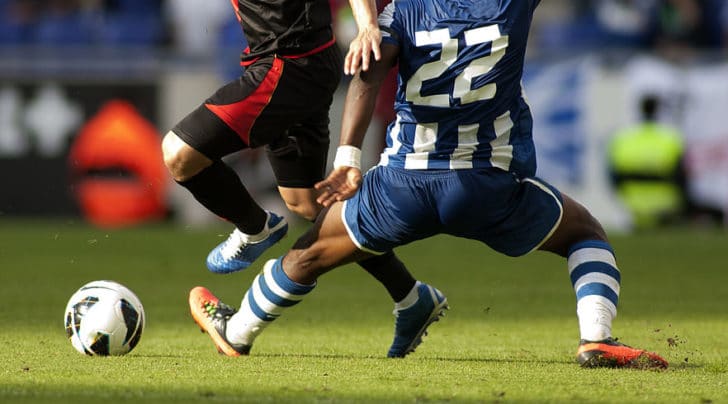
A bucket handle meniscus tear is a unique type of meniscus tear. Bucket handle meniscus tears are more common in younger athletes. They can occur in older adult athletes too, but most bucket handle meniscus tears occur in people under 35 years of age. A bucket handle tear is unique because the entire meniscus tears, flips over and becomes stuck in the middle of the knee joint.
It is essential to treat these tears early because they are very large tears. A bucket handle tear also “locks” the knee. That means that you are not able to fully straighten the knee. A bucket handle tear will usually not go back into its normal position on its own. It often needs our help. Let’s dive deeper.
The majority of these bucket tears can be fixed or sutured back together. In addition to being large, the torn part tends to flip over on itself and become stuck in the middle of the knee joint. If the meniscus flips over, you will find it painful to walk, and it can make it impossible to straighten your knee fully.
A meniscus is a c-shaped disc. We have two menisci within our knee, the medial and the lateral meniscus. A meniscus functions as a shock absorber. The meniscus serves a vital purpose by cushioning our knee when we walk, run, or play. If the meniscus tears, then that support or protection is lost, and osteoarthritis can occur.
What Is A Bucket Handle Meniscus Tear?
As you can see in the above picture, there are many different types of meniscus tears.
Bucket handle tears are most common in young athletes. The injury is usually non-contact and involves twisting or pivoting. Many athletes are injured in the same way.
They plant their leg to twist, pivot or change direction. They almost always feel a pop when the meniscus tears. Most patients with a large meniscus tear, such as a bucket handle or flap tear will develop significant swelling or bleeding in the knee joint.
The injury mechanism for a bucket handle meniscus tear is very similar to the injury mechanism which can create an ACL tear or a patella dislocation. When we see you in the office we are usually able to tell by our examination alone whether or not you have injured your meniscus, ACL or patella.
On examination in our office, we will not be able to straighten your knee, and you will have joint line tenderness. That means that you will have pain when we touch along the area where the meniscus usually attaches to.
When a bucket handle tear occurs, the meniscus supports, or the ligaments that hold the meniscus in place are torn. Without the support that keeps the meniscus in place, the meniscus can flop over like the handle on a bucket. When the meniscus flips over, it becomes stuck in the middle of the knee joint.
That results in a loss of motion because the meniscus is physically blocking you from fully straightening your knee. If you lose the ability to straighten the knee fully, then you have a “locked knee.” Many people with a locked knee are found to have a large piece of the meniscus which has flipped into the middle of the knee joint.
What Symptoms Does A Bucket Handle Meniscus Tear Cause?
Bucket handle tears of the meniscus tend to cause significant swelling and pain when they initially tear. After the initial swelling goes down, you will usually find that you can not straighten the knee. This is what we refer to as a locked knee.
That’s because the torn bucket handle meniscus tear is stuck in the center of the knee and is physically blocking the knee from straightening. Because of the loose piece of meniscus, you will notice a lot of popping, and you will have the sensation that something is stuck deep inside the knee. The knee feels very abnormal.
Many patients with a bucket handle meniscus tear will also complain that the knee feels loose or unstable. They will notice a lot of clunking or catching too.
How Do We Diagnose A Bucket Handle Tear?
A bucket handle tear is not a challenge to diagnose. Your story, as well as our physical examination, will usually raise our suspicion that a large meniscus tear exists. An MRI is usually necessary to confirm whether or not a complete meniscus tear is present. In addition, the MRI will show us if the meniscus is flipped over or if there is a large loose piece of meniscus stuck in the middle of the knee.
How Is A Bucket Handle Meniscus Tear Treated?
Most patients with a bucket handle meniscus tear will need to be treated surgically via an arthroscopy. During an arthroscopy, we put a small camera in the knee to see the meniscus tear.
Again, these tears are usually flipped over and stuck in the middle of the knee. The first thing we do is to push the meniscus back into its normal position. Then we look at the tear and see if it is repairable. Most bucket handle tears can be repaired by placing sutures or stitches in it.
A repair is strongly preferred over removal of the torn piece. We want to try and repair these tears. If we cannot fix it and we remove the bucket handle tear, you will be at high risk for developing osteoarthritis.
While many bucket handle tears can be repaired, others cannot be repaired. The decision of whether or not it can be fixed is made at the time of surgery when we are looking at the meniscus. If the meniscus has a good chance of healing, then we will proceed to repair it. If we do not believe that the meniscus will heal, then we need to remove the torn piece.
Recovery After A Bucket Handle Meniscus Tear
After surgery, you might be on crutches for a short while to protect the internal stitches and allow the meniscus to heal. After therapy and waiting enough time for the meniscus to heal, many athletes can enjoy a full return to activities after repair of a bucket handle tear. Return to sports after the repair of a bucket handle meniscus tear can take 4-6 months or more.
Can the meniscus tear again? Yes, it can. This is not common, but it does occur.
The majority of people who have a bucket handle tear will go on to lead a normal life if the tear is promptly treated, repaired and if the meniscus heals. Unfortunately, there is very little chance that non-surgical treatment will work for these large unstable tears. The timing of meniscus surgery is important too. A bucket handle tear should be fixed within a few weeks from the time the diagnosis is made. When the meniscus is flipped over, it is at risk of losing its normal shape and being torn more. If the meniscus loses its shape or tears more, then it may not be repairable.

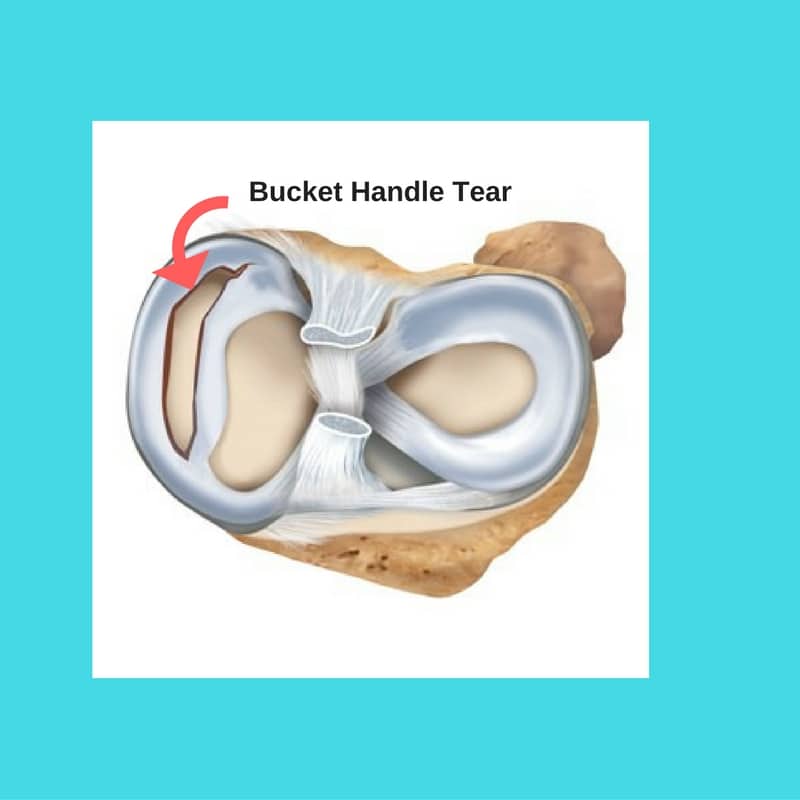
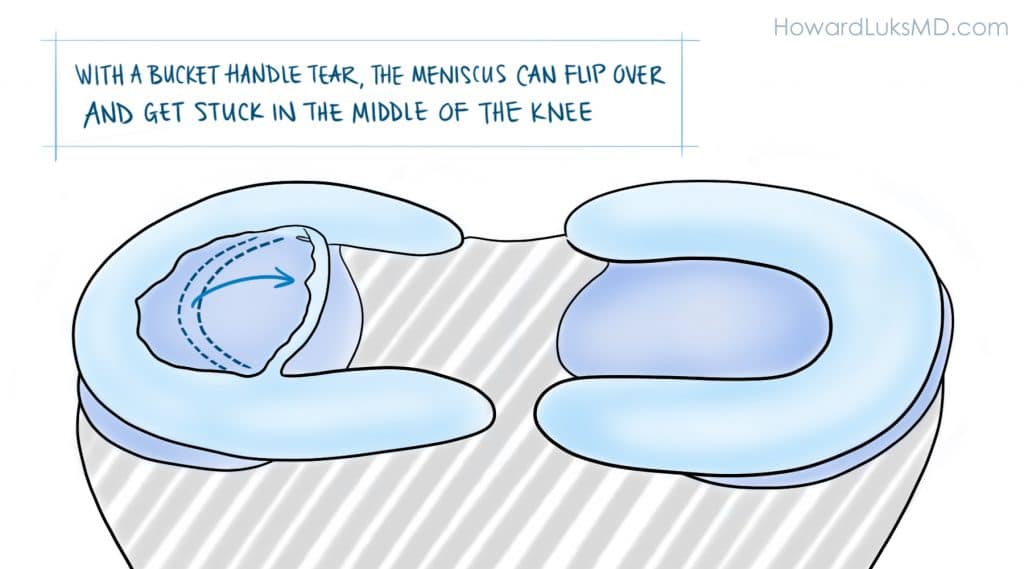
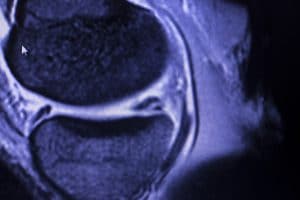
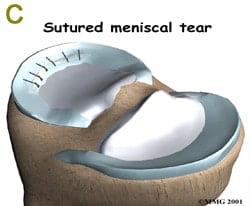
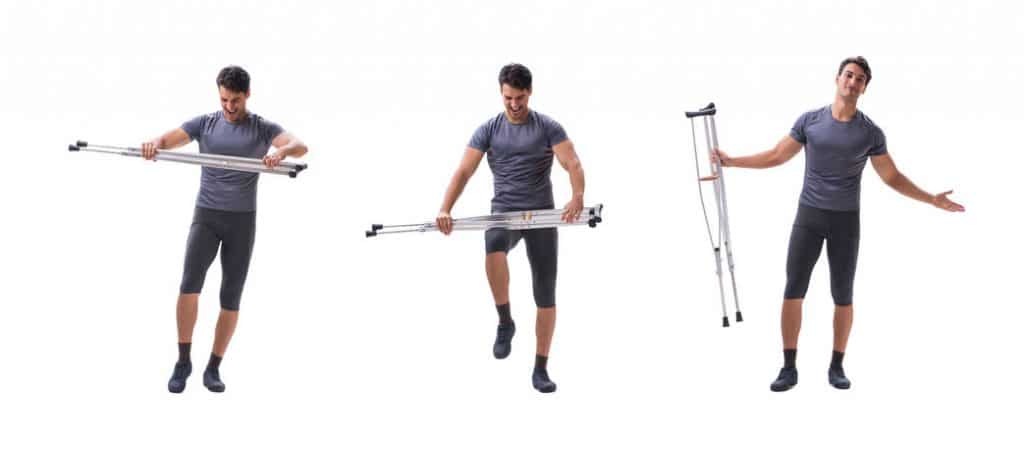





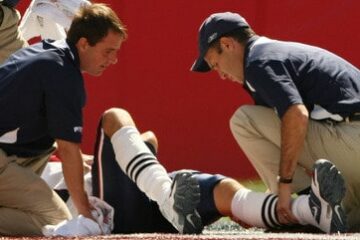





I had an accident at my dance class almost 2 months ago. Initial swelling / pain was gone in a week. Since I could not get my knee back to its routine my ortho suggested an MRI. The results looks as below. I’m not in a constant pain, I wear knee braces, but I cannot stretch my knee, run or get back to my dance yet. The doctor suggests a surgery. But I would like to make sure I ask enough questions before getting in. What are the things that I need to consider before making sure surgery is the only option?
Report as below:
There is a bucket-handle tear of the medial meniscus; a large medial meniscal fragment has flipped
laterally into the intercondylar notch, while remaining attached to the medial meniscus at the
anterior and posterior roots.
The lateral meniscus is normal in signal and morphology.
The anterior cruciate ligament is abnormally sagged in contour; this appearance is indicative of at
least a partial-thickness tear of the ACL, with a proximal full-thickness component not excluded.
Thanks a lot!
Bucket handle tears are best handled by repairing them. That means putting them back into their normal position and putting in a number of sutures or stitches to allow it to heal. You should ask how many of these your surgeon repair with stitches. Some doctors will simply take the torn piece out. So clarify that they will attempt a repair and that they perform enough of them to be comfortable doing it.
Thanks for your quick response Doctor. My ortho says he most probably is going to remove the torn part and suggests a repair of ACL along. Can this not be done by physical therapy and rest? Reason I’m asking is, invariably the long term impact is early onset of Arthritis and slow recovery.
Frankly, I’m not convinced that surgery is the only option. It seemed the doctor was biased with surgery. Is there a way for you to review the results?
Hi Doctor,
I’m a 38 year old highly active male and I injured myself during sport 8 weeks ago.
My MRI report noted, “Bucket-handle tear of the medial meniscus with central displacement of the bucket component. There is horizontal tear involving the residual slightly small meniscal rim.”
My worry is that my injury occured about 8 weeks ago. My doctor’s office and insurance company have been slow to move and I’m worried that I am now past the point where a repair would be successful.
Do you have any idea what the likelihood of success is this far out?
Thank you for reading.
Hi Patrick… We have successfully repaired tears that have been present for many months. It all depends on what the meniscus tissue looks like when we put the camera in the knee. If the tissue is deformed or degenerative we will not be able to repair it.
Good Luck
I had a bucket handle meniscus injury in February. My surgery was one and a half month later. My knee was locked and bent that whole time. After the surgery and 2 months physical therapy, I still had poor range of motion, but could walk with a limp. My surgeon then did a knee manipulation on me 3 weeks later. It’s been 10 days since and my range of motion has not improved and I still walk with a limp. I’ve gone to pt daily and do my home exercises. My knee is so stiff and it still hurts too. I feel like I’m ever going to recover from this and it’s extremely discouraging. What are your thoughts? Will continued physical therapy and home exercises (including recumbent bike) help me? Is there anything else that can be done for me? I just want to get my life back. Please help. Thank you.
A second opinion is probably worthwhile.
Hi Doc!
I have a bucket handle tear on my left knee that I injured playing beach volleyball august 29. It locked my knee completely at the spot. Next day, I saw an orthopedist and he unlocked my knee and with lots of icing and taking care i was able to move again in 10 days. That made me act cocky (and very stupid) and I played ball again. That was right in the 2 weeks range. After playing 6 hours, end of the 6th hour, it locked again. My MRI results (which I have sent to multiple doctors and got results back, doctors recommending surgery) are the results from the previous injury. I have not gotten MRI after the second injury (which is 2 weeks ago from now, which I am following the same healing pattern but definitely staying away from sports). Now… Today, I met with an orthopedic surgeon.. He just spilled the grave news. Those news that 3 people above me mentioned about. He said, if he can’t repair it, he will remove it. That is simply my biggest fear, and reading the lines of the others, wanted me to write this down for the future fellows reading this.
Now.. coming to the crucial point. How hard will this surgeon try to repair it? Is it simply a yes or no decision once the micro camera is in my knee? Or is it a decision that doctor freely takes? Is taking the whole meniscus easier compared to trying to repair it? I’m simply scared, scared a lot that the surgeon I have met with today seemed like he did not care at all about my future sport life, which is basically my whole life.
Thank you in advance for your response!
Hi Sol… Most bucket handle tears are repairable. On rare occasion, they are not repairable. In my experience, I have rarely had to remove them over the last 26 years. Stick with the doc who seems to favor repair over removing it.
Good day Mr Howard,
I’ve injured my knee about 2 weeks ago. I did MRI couple days after.
I have a bucket handle meniscus tear , the doctor suggested surgery but he couldn’t confirm me to either do the repair or just remove the piece.
I booked the surgery but few days before the surgery I cancelled it out of fear and also considering that I am already able to almost fully extend my knee , able to walk normally too and no pain overall , just a sharp pain on my knee for few seconds sometimes .
I’ve being doing exercises to keep the affected leg strong and stay as healthy as possible.
I’m 30 years old and very fit , I wouldn’t consider the surgery unless is really necessary ,the fact of having a 25% chances of a post surgery tear also set me off too .
What are your thoughts ?
If I’m not in pain or real discomfort after 2 weeks should I still do it ?
Also , the doctor just examined me in 2 occasions for less than 5 mins .
I don’t think rushing into a surgery it’s always the best option .
I appreciate the fact that you take time to answer everyone.
Thanks in advance
HI … A repair is certainly preferred to removing the torn piece. I am able to repair over 95% of bucket-handle tears. I would hope that most sports docs would do the same. I cannot advise you on whether or not to have the surgery… but it seems like you should consider a second opinion to find a doc who you have a good rapport with.